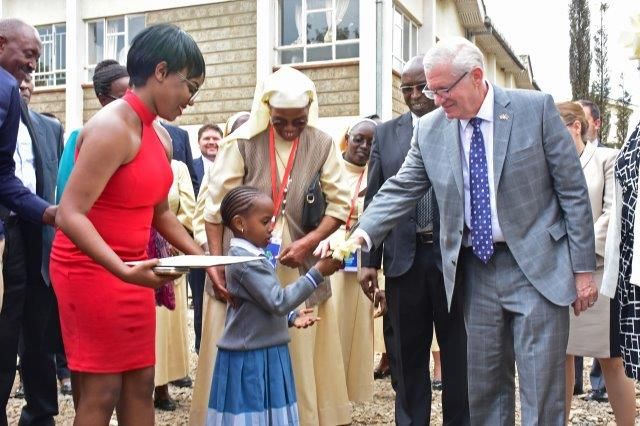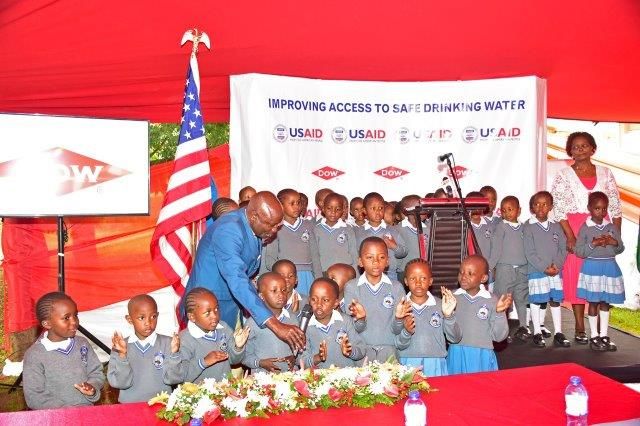An Intermediate Scale Integrated Private/Public Water Supply System in Kasarani, Kenya
Published on by Amleto Pucci, Active Volunteer; Mostly Retired in Non Profit
An Intermediate Scale Integrated Private/Public Water Supply System in Kasarani, Kenya
By Sr. Esther Waithera[i], Sr. Lilia Kagendo[ii], Joe Sanders[iii], Amleto A. Pucci, Jr. Ph.D.[iv], Leonard Kareko[v]
The Little Sisters of Saint Francis Mission at Kasarani, Nairobi District (LSOSF-K) dedicated a state-of the-art Community Water Supply and Fluoride Decontamination Treatment System in June 2018. The LSOSF-K accomplished the project by assembling a team with their own talents which includes the Kenya Integrated Water, Sanitations, & Hygiene project (KIWASH) (a USAID), the development interest of Dow Chemical Co. and their cyber-Grant program, assistance from Water Is Life Kenya (a US-NGO), and engineer volunteers.

Figure 1 A nursery school student gives U.S. Under-Secretary of Commerce, Gilbert Kaplan, scissors for a ceremonial ribbon cutting at the Kasarani Water Supply and Fluoride Decontamination Treatment System Ceremony. Sr. Irmina Nungari and DOW Chemical Co employees.
The project initiated because Nairobi County Water Department had rationed water supply to just three days per week. This restricted the needs for the LSOSF-K Mission to provide services of regional hospital and outpatient medical and nursing care, nurse education, primary and secondary education and public outreach. Measures to shore up these needs by rainfall-roof-runoff capture, enhanced onsite storage, and commercial water truck deliveries were not dependable, stop-gap in nature, or highly expensive.
In 2016 a replacement well was drilled and the yield exceeded the Mission service needs... except water quality had fluoride concentrations >9.0 mg/L, six times WHO maximum for drinking water. Extensive aquifers in the local African Rift Valley are volcanic with high fluoride-mineral content. Constant ingestion by drinking may cause fluorosis, a crippling and life-shortening illness.[vi]


Figure 2 Mt. Laverna nursery school students entertain representatives of U.S. Department of Commerce, DOW Chemical Company, KIWASH, a US-AID Program, visitors, and the Little Sisters of St. Francis at the ceremonies at the Kasarani Water Supply and Fluoride Decontamination Treatment System.
For its participation as an engineering-technical-management team member, KIWASH mandated the project help supply water to supplement the water-rationed Kasarani neighborhoods (2016 estimate for Kasarani was 6,896 people/km2.) The LSOSF-K Mission embraced this role and will retail its treated water, at cost, in “kiosks” located for neighborhood walkup access. With the proviso that the project could be used as an East African demonstration site for its FILMTEC™ decontamination technology, Dow Chemical Co. also joined the team.
Projected to 2021, the community system will meet all the water supply needs within the private LSOSF-K community and the projected demand of over 7,000 people that KIWASH consider within a 15 minute round-trip walk to water vending locations. Unlike other local well-water supply, this vended will meet potable drinking water standards.
[i] Manager, Kasarani Water Project essyben@gmail.com
[ii] Development, Little Sisters of St. Francis, P.O. Box 2518, Binghamton, N.Y. 13902 srliliak@yahoo.com
[iii]Chief of Party, KIWASH, U.N. Crescent, Gigiri,, P.O. Box 1863 – 00621, Nairobi, Kenya Joe_Sanders@kiwash.org
[iv] Communicating and Presenting Co-Author. P.O. Box 78, Erwinna, PA 18920 amletopucci@ptd.net
[v] Technical Team, Dow Chemical Company LKKareko@dow.com
[vi]Excess Fluoride in Water in Kenya, Consultative Committee, Kenya Bureau of Standards, Nairobi, June 2010.
Media
Taxonomy
- Public Health
- Hygiene Education
- Drinking Water Security
- Environmental Health
- Heath & Safety
- Water & Diseases
- Human Rights
- Water & Sanitation
- Empowerment & Right To Water
- Sanitation & Hygiene
- Water Supply
- Sanitation & Hygiene
- Water Supply Design
- Rural Area Water Supply
- Drinking Water Managment
- Drinking Water
- Water Quality Management
- Water Sanitation & Hygiene (WASH)
- Water Supply Protection
3 Comments
-
I believe we could help with this issue using a patented electro-oxidation process that has shown tremendous success in contaminated water reuse. We would be glad to look at your issue if you would send a detailed water analysis and/or water samples to examine.
1 Comment reply
-
Thanks Jim for your kind offer. Please send me a link to the information. It will not be useful for this project which is up and running. Your interest is appreciated.
-
-
Incredible. WaterAid Ghana works in high fluoride concentration region and we need a technology to deal with the issue. Grateful for more information on the technology; cost, how it operates, etc.
1 Comment reply
-
I Jesse. Thank you for your enthusiasm about this Water Supply and Fluoride Decontamination project. The DOW Chemical Co. FILTERTEC (TM) technology is a robust, state of the art membrane technology for large water-flow decontamination applications. There are other techniques which are less state-of-the-art and capital intensive too. I will be glad to send you a review paper on various techniques for small- to mid-size fluoride decontamination techniques. Let me know.
-
-
Recommendable initiative!
1 Comment reply
-
Thanks Patrick. It was a fine team effort.
Now the Little Sisters of St. Francis-Kasarani Water Project is developing a dedicated solar power plant for this operation. Electric power for this project technology ideally should be well behaved, dependable, and not subject to brown-outs etc. Current electric power supply in the area is described as not ideal for the many motors, pumps, controls, valves etc. for the total production installation.
So far reports are that it is just doing fine :-)
-